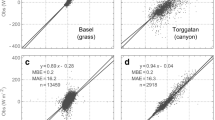Abstract
The 1-year (2009–2010) measurements are analyzed of the urban surface energy balance (SEB) obtained from the sensors located at three vertical layers of a 325-m tower in downtown Beijing. Results show that: (1) The measurements from the 325-m tower represent the SEB characteristics of the cities located in semi-humid warm-temperate continental monsoon climate zone. In a typical hot and rainy summer, cold and dry winter, the measured Bowen ratio is minimum in summer and maximum in winter. The Bowen ratio measured at 140 m for spring, summer, autumn, and winter are 2.86, 0.82, 1.17, and 4.16 respectively. (2) At the height of 140-m (in the constant flux layer), the noontime albedo is ∼0.10 for summer, ∼0.12 for spring and autumn, and ∼0.14 for winter. The ratios of daytime sensible heat flux, latent heat flux, and storage heat flux to net radiation are 0.25, 0.16, and 0.59 for clear-sky days, and 0.33, 0.19, and 0.48 for cloudy days respectively. (3) Under clear-sky days, the nighttime sensible heat flux is almost zero, but the latent heat flux is greater than zero. For cloudy days, the nighttime sensible heat flux is slightly greater than the latent heat flux in winter. The nighttime upward heat flux is presumably due to the anthropogenic release (mainly latent heat for summer, while latent and sensible heat for winter).
Similar content being viewed by others
References
Wang G T, Wang X Y, Miao S G, et al. Research and application on the technology system of multi-scale assessment of the impact on the atmospheric environment by urban planning. Sci China Ser D-Earth Sci, 2005, 35 (Supp1 II): 173–184
Mestayer P G, Durand P, Augustin P, et al. The urban boundary-layer field campaign in Marseille (UBL/CLU-ESCOMPTE): Set-up and first results. Bound-Layer Meteor, 2005, 114: 315–365
Rotach M W, Vogt R, Bernhofer C, et al. BUBBLE—An urban boundary layer project. Theor Appl Climatol, 2005, 81: 231–261
Allwine K J, Flaherty J E. Joint urban 2003: Study overview and instrument locations. Technical Report, Pacific Northwest National Laboratory, United States Departement of Energy. 2006. [http://www.pnl.gov/main/publications/external/technical_reports/PNNL-15967.pdf
Liu H Z, Hong Z X. Turbulent statistical characteristics over the urban surface (in Chinese). Chin J Atmos Sci, 2002, 26: 241–248
Xu X D, Ding G A, Bian L G, et al. Characteristics of atmospheric environment of boundary layer structure of city community in BECAPEX and integrate influence (in Chinese). Acta Meteorol Sin, 2004, 62: 663–671
Xu Y Y, Liu S H, Hu F, et al. Influence of Beijing urbanization on the characteristics of atmospheric boundary layer (in Chinese). Chin J Atmos Sci, 2009, 33: 859–867
Wang C G, Sun J N, Hu F, et al. Observation and analysis of the characteristics of urban concrete surface energy balance (in Chinese). J Nanjing Univ, 2007, 43: 270–279
Wang X P, Wang L L, Gao Z Q, et al. Measurements of atmospheric boundary layer over Beijing area in summer (in Chinese). Clim Environ Res, 2008, 13: 629–638
Wang J. Innovative scientific achievements of China’s 60: Contribution of 325 m observation tower. Science Times, 2009-08-24, http://www.edu.cn/60rd_8419/20090824/t20090824_401828.shtml
Wang Z X, Jinag Y H, Li J, et al. Study on measurement of urban boundary layer radiation on the meteorological tower in Beijing (in chinese). Plateau Meteorol, 2009, 28: 20–27
Peng Z, Hu F. A study of the influence of urbanization of Beijing on the boundary wind structure (in Chinese). Chin J Geophy, 2006, 49: 1608–1615
Roth M. Review of atmospheric turbulence over cities. Q J R Meteorol Soc, 2000, 126: 941–990
Beijing Meteorological Bureau Climate Data Center. Climatography of Beijing. Beijing: Beijing Publishing Group LTD, 1985
Webb E K, Pearman G I, Leuning R. Correction of flux measurements for density effects due to heat and water vapor transfer. Q J R Meteorol Soc, 1980, 106: 85–100
Grimmond C S B, Salmond J A, Oke T R, et al. Flux and turbulence measurements at a densely built-up site in Marseille: Heat, mass (water and carbon dioxide), and momentum. J Geophys Res, 2004, 109: D24101
Jiang X Y, Zhang C L, Gao H, et al. Impacts of urban albedo change on urban heat island in Beijing—A case study (in Chinese). Acta Meteorol Sin, 2007, 65: 301–307
Jiang Y H, Wang Q, Zhang H S, et al. Radiation characteristics of urban boundary layer measured on the meteorological tower in Beijing (in Chinese). Plateau Meteorol, 2010, 29: 918–928
Wilson K, Goldstein A, Falge E, et al. Energy balance closure at FLUXNET sites. Agric For Meteorol, 2002, 113: 223–243
Grimmond C S B, Oke T R. Heat storage in urban areas: Local-scale observations and evaluation of a simple model. J Appl Meteorol, 1999, 38: 922–940
Christen A, Vogt R. Energy and radiation balance of a central European city. Int J Climatol, 2004, 24: 1395–1421
Kawai T, Kanda M. Urban energy balance obtained from the comprehensive outdoor scale model experiment. Part I: Basic features of the surface energy balance. J Appl Meteorol Clim, 2010, 49: 1341–1359
Grimmond C S B, Oke T R. Comparison of heat fluxes from summertime observations in the suburbs of four North American cities. J Appl Meteorol, 1995, 34: 873–889
Moriwaki R, Kanda M. Seasonal and diurnal fluxes of radiation, heat, water vapor, and carbon dioxide over a suburban area. J Appl Meteorol, 2004, 43: 1700–1710
Oke T R, Spronken-Smith R A, Jauregui E, et al. The energy balance of central Mexico city during the dry season. Atmos Environ, 1999, 33: 3919–3930
Cai X H. Footprint analysis in micrometeorology and its extended applications (in Chinese). Chin J Atmos Sci, 2008, 32: 123–132
Author information
Authors and Affiliations
Corresponding author
Rights and permissions
About this article
Cite this article
Miao, S., Dou, J., Chen, F. et al. Analysis of observations on the urban surface energy balance in Beijing. Sci. China Earth Sci. 55, 1881–1890 (2012). https://doi.org/10.1007/s11430-012-4411-6
Received:
Accepted:
Published:
Issue Date:
DOI: https://doi.org/10.1007/s11430-012-4411-6




